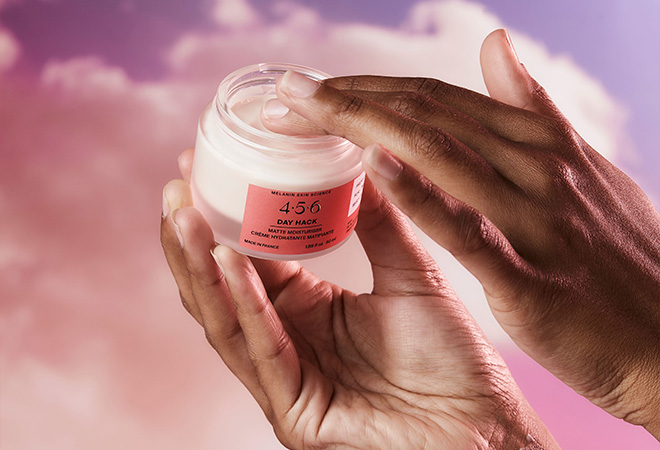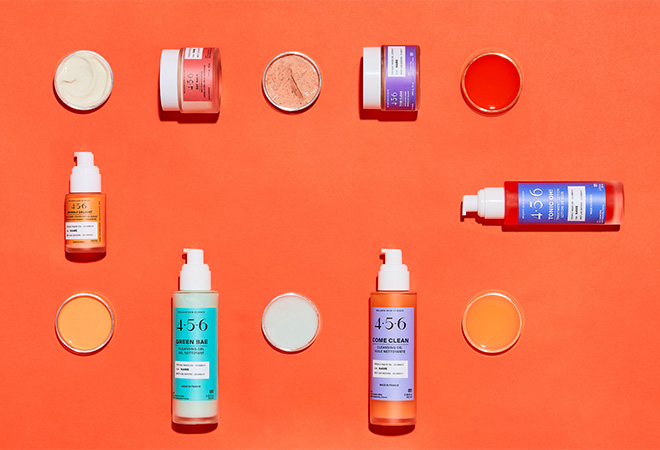“Melanin-rich skin, in our industry, has been like the white elephant in the room that everyone sees and swears is not there,” 4.5.6 Skin founder Noelly Michoux passionately declares. Fellow voices in the industry like Dr. Anne Beal have appealed for skincare that caters to the specific needs of this demographic, but a majority of the industry operates on a skin type-specific, rather than biological makeup-specific approach. Customized products offered by the likes of Revea or Veracity are another avenue taking ethnicity into consideration.
Michoux’s journey exemplifies the need for a paradigm shift away from traditional methods of product creation. If brands proclaim themselves as embracing diversity, the journey needs to begin in the lab, not in their marketing campaign creation strategy. 4.5.6 Skin was given the rare opportunity of being part of the LVMH Research Center’s Cosmet’up Program, giving the company a chance to build their own lab and production unit from the ground up, led by a diverse team every step of the way.
She created her brand’s skincare based on the Fitzpatrick system, which classifies skin into six different categories depending on factors like sun sensitivity. As Michoux explains, the industry operates all of its innovation, research, development, dermatology, treatments, and skincare based on the prototypes 1, 2, and 3, which all are within the white skin range. 4, 5, and 6 are the more melanin-rich skin types, often from geographic areas like Africa or Southeast Asia. For those who have moved away from these climates, their new environments affect their skin health in a profound way: deregulation, skin sensitivity, moisture loss. Furthermore, the two camps of skin prototypes (1, 2, 3 vs. 4, 5, 6) age differently.
In the following interview, Michoux explains the science behind differing skin needs, authentic diversity, and building a disruptive skincare brand in the French Cosmetic Valley.
What was the gap in the market for melanin-rich skin?
We grow up in a society where we feel that skin is skin, right? We never get to look at the nuances that actually make people different. I grew up as a Black woman in France, not ever being very satisfied with my skincare products. I was never able to find one that was hydrating enough for my skin, so I just felt that my skin was not compliant. You never think that the problem is that these products are not made for you in the way that they should be.
If you look at the structure and the function of the skin, you'll see that Black skin, as opposed to white skin, is denser, thicker, and produces more collagen and elastin. It's a much stronger barrier than white skin which ages a lot more, hence why the industry is all about anti-aging. When you think about that, and correlate it to hydration, which is the mother of everything, the problems start there.
Then you look at what we call the desquamation of the skin [shedding of the epidermis]. People with darker skin actually desquamate 2 and 2.5 times more than light skin. If you combine that with the lack of hydration, you get dull skin. That's what we call ashy skin. When you look at how melanin is produced and the cells that produce the melanin pigment behave for white skin, they're really small. For prototypes 4, 5, and 6 they are huge, very active, and very robust because they have to produce so much melanin, which plays a protective role. But that is a double-edged sword, because if melanin protects your skin, that also means that anything your skin interprets as an irritation is going to trigger the melanocytes side to go into overdrive mode, which is why hyperpigmentation is such a pain point.
The industry is just not factoring these very important facts into the genesis of product creation. People have been confusing that problem with lack of representation, which is a completely different issue. What you see brands doing now is going, “We’re inclusive, all about diversity, and putting people in our marketing campaigns.” That's just part of the problem, it's not very genuine. If you're creating products having one type of person in mind, and then you're financially targeting other kinds of people, that is bizarre to me. You're seizing a financial opportunity that's not being inclusive.
For skincare, you really need to look at people’s physiology, because there are differences there. There are so many nuances in us as a species. These differences are what make us interesting and beautiful. If any brand today is going to prove that they’re inclusive and about the whole system in their communication, then this is where they actually need to start. As a brand, if you know that your entire value chain will not be inclusive, then you should say, “I want to be an ally, but today I'm not able to be inclusive.” That's okay, because not all brands can tend to all people.
What challenges were there in setting up the brand?
The industry itself has been conditioned by its drivers. Skincare is a marketing-driven industry, so the person with the most means gets to tell the story of how it should be done, what it should be like, and what the ideals are. It has nothing to do with the truth or what is actually right.
When I started talking to the lab in France, the response was, “We don't do products for darker skin tones, but you can use the formulas that we have and tweak them, add key ingredients that speak to your community, some fragrance, and you should be good to go.” This is how the industry works now. 99% of the stock you see out there is those formulations. The big guys have their own labs and R&D. Anyone else that does not have that access goes to existing formulations and packaging.
I couldn't find a partner that was willing to do what I was trying to create, because they were not seeing the problem as well. In the pre-Fenty era beauty industry, basically the attitude was an outdated aesthetic, with a lack of representation in campaigns and R&D, as well as lacking awareness in terms of the suppliers. Things are changing, but we have a lot of work in terms of educating consumers, bringing it back to their physiology, understanding themselves so that they can use that knowledge to make better-informed decisions about their beauty products.


